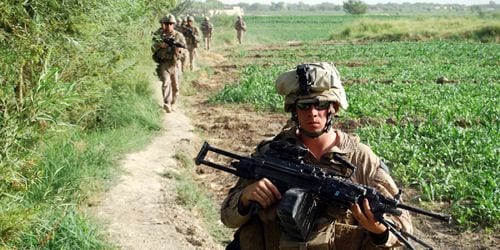
Our policy makers do not understand that the very presence of our forces in the Pashtun areas is the problem. The more troops we put in, the greater the opposition.
Afghan social, political, economic, and cultural affairs are complex and poorly understood. ISAF does not sufficiently appreciate the dynamics in local communities, nor how the insurgency, corruption, incompetent officials, powerbrokers, and criminality all combine to affect the Afghan population.
President Obama needs a legitimate Afghan partner to make any new strategy for the country work. However, the extensive fraud that took place on Aug. 20 virtually guarantees that a government emerging from the tainted vote will not be credible with many Afghans.
Obama’s War starts on the ground. Over images of U.S. Marines in the Helmand desert, Lt. Colonel Christian Cabaniss urges, “Make no mistake. We’re experts in the application of violence. We’re attacking to seize control of the population from the Taliban. The people are our objective.”
Such self-assessment, acute if arrogant, lays out both the strength and fragility of the American mission thus far. According to the season premiere of Frontline, this mission is redefined daily, and not always by the United States alone. As noble or practicable as American aims may be, they are incessantly reshaped by multiple factors. Even as U.S. generals (namely, David Petraeus and Stanley McChrystal) advocate a new and improved counterinsurgency doctrine (involving more troops interacting more regularly with the “population”), the administration faces proliferating complications, including Taliban incursions into Afghanistan and Pakistan.
Some immediate dangers are made plain in the opening frames of Obama’s War. As reporter Martin Smith observes, “The fighting was often heavy,” photojournalist Danfung Dennis‘ footage shows men lurching, shouting, and shooting amid a red-dusty haze and spidery tree branches. This confusing terrain serves as an evocative metaphor for the task at hand: in several scenes, soldiers are unable to see their combat opponents or communicate constructively with “the population.”
ISAF (International Security Assistance Force) efforts to implement what Petraeus terms “full spectrum operations” meet with daily obstacles. Even as Echo’s commander, Capt. Eric Meador, describes current strategy (“You have to be with the population and close to them so you can work with them”), Obama’s War shows a young soldier grappling with insecurities, both his own and the farmers he’s trying to win over. When they describe Taliban threats, he instructs his translator, “Tell the men, don’t run and don’t start stuffing stuff in your pockets. That looks suspicious.”
If “the people are our objective,” such tensions must be addressed more consistently and effectively. This is the fundamental point made by ISAF’s director of intelligence, Major General Michael T. Flynn: “This is a war about personal relationships. It has to be a cultural shift in how we think about what we’re doing. This is how we will succeed.” But even as he argues for soldiers “getting out of our large vehicles and out from behind our sunglasses and all this gear that we wear and literally just getting out among the population, so they see us as human beings and treat them as such rather than looking like something out of Star Wars to ’em,” what you see are troops in helmets and camo and sunglasses, looking frustrated and not a little alien.
Beyond these daily and continually mutating concerns, the intelligent and unsettling Obama’s War looks at big-picture questions. For one thing, Seth Jones says, “A strong central government is completely ahistorical in Afghanistan.” For another, August’s patently rigged Afghan election rises doubts as to whom exactly the U.S. is supporting (as Frank Rich contends, changes fundamentally what’s at stake for Americans and Afghanis “on the ground,” including Obama’s assessment that this is a “war of necessity”). Moreover, the administration faces the ongoing problem of AfPak.
The New Yorker‘s Steve Coll submits that the war is complicated for this reason: “If you think about it, the United States is essentially waging a war against its own ally,” that is, “The Taliban are a proxy of the government of Pakistan. We are an ally of the government of Pakistan. We are fighting the Taliban.” (The Obama administration has recently floated the possibility of working with “moderate” Taliban elements.) On top of this blunt assessment, Smith narrates, “Privately, several administration officials told Frontline they worried about the duplicity of Pakistani officials and how to develop a clear policy towards Pakistan.”
With so many ways for the war to go wrong, Obama’s War suggests, the deployment of more troops — announced and unannounced, combat and support — hardly inspires confidence. Celeste Ward, Deputy Assistant Secretary of Defense for Stability Operations (2007-2008) and now a senior defense analyst at the RAND Corporation, says the problem with seeking a “stable Afghanistan: “The problem is it’s terribly vague about exactly what it is that you’re required to build and to what point. And how do I know when I’m done? Until you have specified what the end state is you’re aiming for, then counterinsurgency is a recipe for presence in perpetuity.” In asking so many questions, Obama’s War makes clear that what’s “on the ground” is only a beginning.

![Call for Papers: All Things Reconsidered [MUSIC] May-August 2024](https://www.popmatters.com/wp-content/uploads/2024/04/all-things-reconsidered-call-music-may-2024-720x380.jpg)



